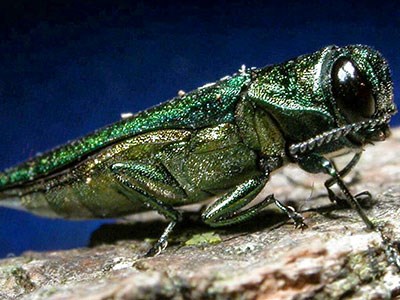Sault Ste. Marie company BioForest Technologies, the maker of TreeAzin, a natural pesticide that destroys the emerald ash borer (EAB) beetle, has been sold to a larger company.
Last April, BioForest was acquired by Lallemand, a Montreal-based business that develops, produces and markets yeast, bacteria and specialty ingredients. The family-owned venture has products across sectors, including human and animal nutrition, pharma and health applications, and biofuels and distilled spirits.
With the sale, BioForest becomes the Lallemand’s forestry unit within the company’s plant division.
After 20 years building BioForest up from scratch, president Joe Meating said the merger is bittersweet. But the union with Lallemand serves as a kind of succession plan for the company, as Meating starts planning for his eventual retirement.
“They came knocking on our door, and the time was good,” said Meating, a former forest insect control officer with the Canadian Forest Service (CFS). “We were growing very rapidly, we had good sales, and it just seemed to be a good fit for us and for them.”
BioForest’s focus remains pest management through non-chemical treatments, such as microbials, fungi, bacteria and other microorganisms.
Because Lallemand has operations in more than 25 countries, BioForest now has access to a wider breadth of research and development expertise, which Meating hopes to leverage for use in forestry.
“They have a number of products they had developed for crops — fruit and vegetables — that we think could have applications in forestry,” he said. “So we’re going to be doing some research to test them to see if they perform as well on trees as they do on tomatoes.”
Research remains a cornerstone of the company and a number of other projects are underway.
BioForest is sending one employee to complete the Master’s-level forest conservation program at the University of Toronto, and is additionally working with a Nipissing University student to look at how emerald ash borer is changing bird populations and species diversity.
Though that work moves beyond the scope of pest management, Meating said it’s all connected.
“You’ve got to look at the big picture — it’s not just trees dying,” he said. “It’s a whole canopy that’s changing, which affects the birds and other insects and mammals.”
Native to Asia, the emerald ash borer is an invasive species that targets ash trees. The beetle’s larvae feed on the tree, eventually killing it.
But BioForest found that, by applying TreeAzin, manufactured with components from the neem tree, early on in an EAB outbreak, ash trees can be saved, reducing the negative environmental and monetary impacts of simply cutting the trees down.
Meating has been working closely with the City of Thunder Bay, which just confirmed the presence of emerald ash borer in June, to devise a treatment plan using TreeAzin. Meating said in the past, many communities didn’t start treatment early enough to save their ash trees, but Thunder Bay has been proactive in its approach to the beetle and has a good chance of saving its trees from an infestation.
“Thunder Bay, clearly, they probably had the best plan I’ve seen,” Meating said. “They started preparing for EAB five years ago, and so they had a good communications plan, council was aware of the problem, senior managers were aware, the public was aware, so they’re just kicking that whole thing into gear now and hopefully it’ll go well for them.”
The city is currently trapping the bugs around the city to delineate the infestation so it can take a targeted approach to stopping it in 2017. Meating said it’s cost-effective and practical than treating every tree in the city, which amounts to “throwing darts at the wall and hoping you hit something.”
Although BioForest has reduced the cost of treatment by 45 per cent since its inception, price remains the primary drawback for potential customers to get on board with the treatment.
Making the product is more complex than making a chemical counterpart, but the Canada-U.S. dollar exchange also plays a role: BioForest is paying 30 per cent more for its raw ingredients than it was a year ago, making it difficult to bring down the price further.
But cities are starting to realize the benefits irrespective of price. Over the last year, BioForest secured its largest U.S. city to date when St. Louis signed on to a TreeAzin treatment plan for its trees. It was a coup for the company.
“It’s a TreeAzin-only program down there, and we’re up against some very stiff chemical competition in the U.S.,” Meating said. “This was a nice breakthrough for us, and it was based on the municipality’s concern for environmental effects of the options, as well as looking at our data and seeing they could be just as effective using a somewhat softer botanical pesticide or biopesticide.”
Meating expects it’ll still be some time before he hangs up his lab apron for good, but he said he can rest easy knowing BioForest has been left in good hands when the time for retirement finally arrives.
“(Lallemand is) a neat company,” he said. “I like the fact it’s Canadian, it’s family-owned, and they’re a good bunch of people. I’ve enjoyed working with them.”




